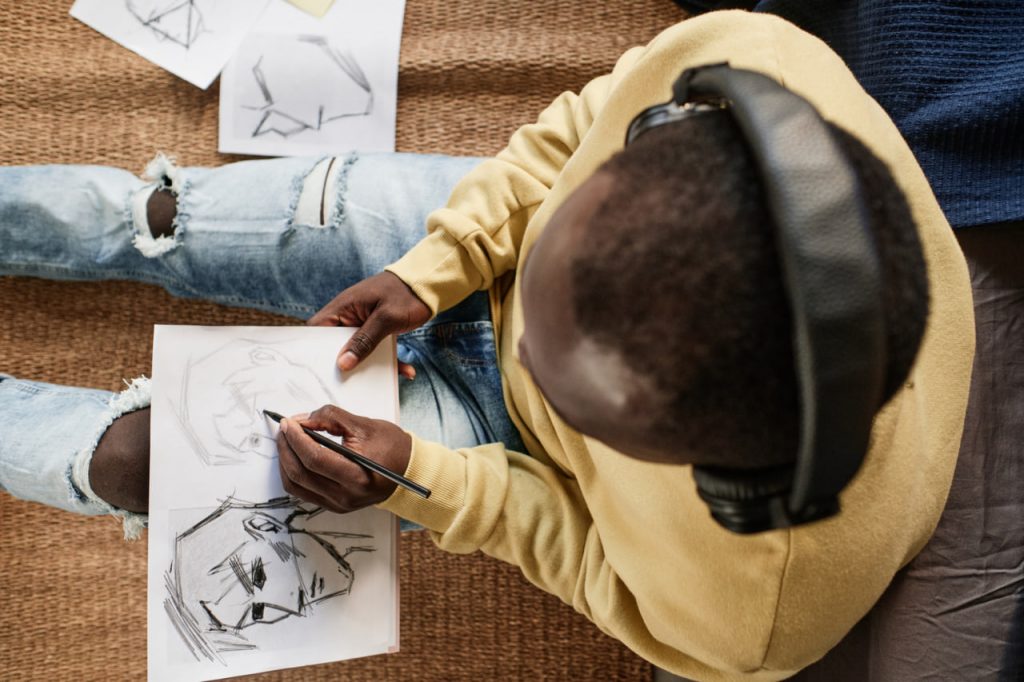Why Most People Start with Symbols
When most people begin drawing, they don’t actually draw what they see — they draw what they know. A sun becomes a yellow circle with rays. A person becomes a stick figure with a smiling face. These are visual symbols: simplified mental representations rather than accurate observations. While this symbolic drawing feels familiar and easy, it quickly becomes a wall when you try to draw with realism or depth.
The Shift from Symbols to Structure
Learning to see like an artist means breaking away from symbolic thinking and training your eyes to observe what’s really there. This shift can feel frustrating at first, especially if you’re used to drawing quickly or intuitively. But when you start to observe angles, proportions, negative space, and how light wraps around form, your drawings begin to take on a sense of weight, depth, and life.
Gesture Before Details
One of the first steps in developing an artist’s eye is learning to capture gesture — the overall movement or flow of a subject. Beginners often focus on outlining details, but those details fall apart without a solid underlying gesture. Gesture drawing trains you to see the energy and rhythm of a pose or object, rather than its surface shape. It encourages fluidity and confidence rather than stiffness and overthinking.
From Stick Figures to Volume
Stick figures are not wrong — they’re just incomplete. They offer a useful starting point for understanding basic anatomy and movement. But to move forward, artists must begin thinking in volumes. That means drawing cylinders instead of limbs, boxes instead of torsos, and spheres instead of heads. These basic 3D shapes allow you to rotate your subject in space, maintain consistency, and build believable forms.
Construction Drawing: The Artist’s Blueprint
Construction is the method of building drawings from the inside out. Instead of outlining what you see, you construct it using form logic. You begin with a general volume, then refine it by slicing planes, adding perspective, and adjusting angles. This method mirrors how sculptors build with clay — mass first, details later. It may seem mechanical at first, but it’s the most reliable path toward accurate, dynamic drawing.
Learning to Measure with Your Eyes
Observation is a skill, not a talent. Artists train their eyes to see angles, lengths, and alignments with precision. They compare the tilt of a shoulder to the tilt of a hip, measure the distance between facial features, and observe how light defines edges. These skills can be trained through exercises like sight-size drawing, comparative measurement, and negative space studies. The more you practice, the more accurate and intuitive your observations become.
Drawing Is Seeing
Ultimately, drawing is not just about your hand — it’s about your eyes and how they interpret the world. Once you understand that your hand simply follows what your eye understands, you realize that the core of your improvement lies in learning to see. Structure, proportion, value, and form are visual understandings, not mechanical tricks.
Letting Go of Perfectionism
Many beginners struggle because they expect their drawings to look perfect immediately. But learning to see takes time. Every artist goes through the awkward transition from symbolic to structural drawing. Mistakes are not failures — they’re signs that your perception is being challenged and reshaped. Instead of erasing or avoiding your errors, study them. They’re your clearest guide to growth.
Practice with Purpose
Random sketching won’t get you far if you don’t understand what you’re trying to train. Purposeful practice — such as drawing from life, breaking objects into simple forms, analyzing master drawings, or redrawing the same pose multiple times — will help you internalize structural thinking. Over time, what once felt difficult becomes automatic.

